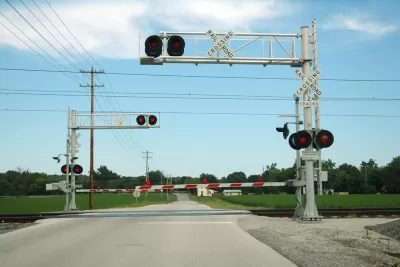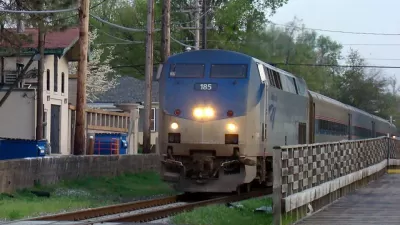Next year, trains traveling at up to 110 mph will speed through grade crossings faster than the current trains traveling at up to 79 m.p.h, and motorists need to prepare for crossing gates that will stay down up to three times longer.

It's not just a matter of the length of gate down time, but that the gates will come down "up to a minute (or) minute and a half" before the higher-speed trains arrive, meaning that motorists, pedestrians and cyclists won't be able to hear or see the oncoming train as is currently the case, states rail safety expert Mike Stead in a video accompanying The State Journal-Register article.
Consequently, road users "will have to trust that the warning system is providing them with the correct information that a train is approaching," Stead warns. Considering the number of fatalities and injuries caused by impatient drivers who knowingly break the law by driving around descended railroad gates, the longer downtimes without signs of an oncoming train may exacerbate grade crossing crashes.
To prevent motorists from even considering driving around the closed gates, quad gates will be installed, along with other safety improvements such as positive train control, illustrated in a clever Amtrak safety video.
"State transportation officials have set a goal of Amtrak speeds up to 110 mph on much of the Chicago-St. Louis corridor in 2017," reports Tim Landis.

There were 141 collisions at all Illinois rail crossings in 2015, the highest figure since 2008, according to ICC figures. Collisions with vehicles resulted in 15 deaths and 76 injuries. There were 16 pedestrian deaths and eight injuries.
In addition to quad gates, positive train control will also be in place for the faster trains.
"The system sends a signal to an operator of an oncoming train if there is a vehicle at a crossing so the operator of train can slow down and stop the train," reports Joseph Bustos for Mass Transit.
"If he or she doesn't react to the warning, the train will begin to shut down automatically to minimize and hopefully eliminate any crashes," said Scott Speegle, Passenger Rail Marketing manager for Illinois Department of Transportation (IDOT).
The trade-off for longer wait times for motorists at grade crossings are shorter trip times for those on the train. The higher-speed trains are expected to take "one hour off the train ride that now takes about 5 hours and 15 minutes," reports Bob Okon for The Herald-News.
Faster trip times will hopefully attract more riders, but unlike the roads that experience congestion with more use, more passengers will make the Chicago-St. Louis- higher-speed train service more sustainable.
When the higher-speed train service arrives next year, it will be among the first rail successes that trace back to President Obama's much-criticized 2009 Recovery Act.
Hat tip to AASHTO Daily Transportation Update.
**The 110 m.p.h. train service is referred to as "high-speed" by IDOT and media outlets which report on it, but Planetizen is more comfortable calling it "higher-speed."
FULL STORY: Crossing technology a sign of faster trains to come

Study: Maui’s Plan to Convert Vacation Rentals to Long-Term Housing Could Cause Nearly $1 Billion Economic Loss
The plan would reduce visitor accommodation by 25,% resulting in 1,900 jobs lost.

North Texas Transit Leaders Tout Benefits of TOD for Growing Region
At a summit focused on transit-oriented development, policymakers discussed how North Texas’ expanded light rail system can serve as a tool for economic growth.

Why Should We Subsidize Public Transportation?
Many public transit agencies face financial stress due to rising costs, declining fare revenue, and declining subsidies. Transit advocates must provide a strong business case for increasing public transit funding.

How to Make US Trains Faster
Changes to boarding platforms and a switch to electric trains could improve U.S. passenger rail service without the added cost of high-speed rail.

Columbia’s Revitalized ‘Loop’ Is a Hub for Local Entrepreneurs
A focus on small businesses is helping a commercial corridor in Columbia, Missouri thrive.

Invasive Insect Threatens Minnesota’s Ash Forests
The Emerald Ash Borer is a rapidly spreading invasive pest threatening Minnesota’s ash trees, and homeowners are encouraged to plant diverse replacement species, avoid moving ash firewood, and monitor for signs of infestation.
Urban Design for Planners 1: Software Tools
This six-course series explores essential urban design concepts using open source software and equips planners with the tools they need to participate fully in the urban design process.
Planning for Universal Design
Learn the tools for implementing Universal Design in planning regulations.
City of Santa Clarita
Ascent Environmental
Institute for Housing and Urban Development Studies (IHS)
City of Grandview
Harvard GSD Executive Education
Toledo-Lucas County Plan Commissions
Salt Lake City
NYU Wagner Graduate School of Public Service




























